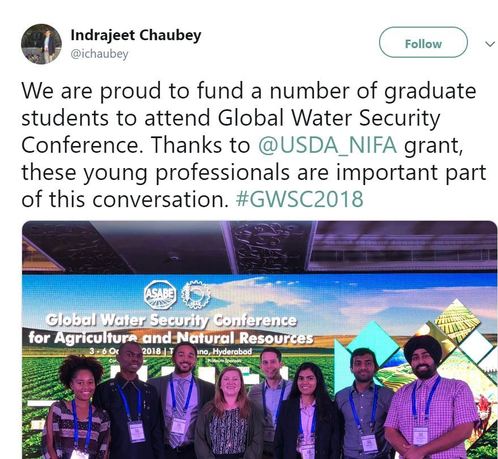|
Having trouble viewing this email? View it as a Web page.

|
|
|
Fresh from the
Field is a weekly album showcasing transformative impacts made by
partners supported by the National Institute of Food and Agriculture.
Editor: Falita Liles Oct.18, 2018
|
|
Success Stories
 Kentucky State University Strengthens Refugee Farms
A team from Kentucky State University (KSU) Extension is working with refugee beginning farmers, helping them start operations to meet a growing demand for fresh food in urban areas. The team is using 1890 Capacity Building Grant funds (1890 CBG), along with support from NIFA’s Beginning Farmer and Rancher Development Program, to develop agricultural systems with high profitability, low investment cost, and relatively low risk. Over the last year, KSU has provided support to more than 290 beginning farmers.
In one case, KSU helped construct a high tunnel and taught refugee farmers how to extend their growing season. Another project was to help refugees start their own farmers market that targets food deserts and organic produce sales to Louisville restaurants. In Bowling Green, refugees learned to use black plastic mulching and irrigation technology – injecting fertilizers into irrigation water – to raise onions, lettuce, greens, turnips, and other vegetables in a hydroponics system.
Read the full story at KSU Extension's AgKnowledge. USDA Photo.
|
News Coverage
 Alabama Ensuring the Cotton Industry Doesn’t Shrink
From the shirts on our backs to the bandages we use to help heal our wounds, cotton is an important part of our daily lives. Unfortunately, many challenges, such as changes in climate and shrinking arable lands, threaten future crop production. Now, researchers at Alabama A&M University are working to ensure that cotton of the future can thrive in warmer, drier, and saltier growing climates.
Researchers are using NIFA 1890 CBG funds to better understand the nature and genetics of the crop. By sequencing the genes of cotton’s parental varieties, researchers hope to improve productivity and fiber quality and help crops to thrive in challenging growing conditions, including temperature, drought, and insect pests.
Ensuring resilience in the U.S. cotton crop matters because the U.S. cotton industry contributes over $25 billion in products and services annually, and accounts for more than 400,000 jobs. USDA photo.
|
Library

It’s a Small World After All
Delaware State University (DSU) used a Capacity Building Teaching grant to give its students the world. In turn, they also built stronger ties of research and learning with other 1890 institutions, universities in Costa Rica, and USDA.
DSU’s programs give undergraduate and graduate students the chance to study abroad with a focus on agriculture and trade. To date, 39 students from five 1890 institutions have studied at two universities in Costa Rica— the Tropical Agricultural Research and Higher Education Center (CATIE) and Escuela de Agricultura de la Región Tropical Húmeda (EARTH University).
The discussions and exercises help students appreciate other cultures and understand what is involved in exporting fresh tropical produce to the United States. In addition, CATIE and EARTH universities prepare students for careers at USDA agencies.
To date, Tuskegee University, Alabama A&M University, Florida A&M University and University of Maryland Eastern Shore have participated in this program. Tuskegee University and Alabama A&M University also used NIFA funds to support their students in this program. USDA photo.
|
Tweet of the Week
#NIFAIMPACTS

|
|

NIFA’s mission is to invest in and advance agricultural research, education, and extension that solve societal challenges. NIFA’s investments in transformative science directly support the long-term prosperity and global preeminence of U.S. agriculture. To learn more about NIFA’s impact on agricultural sciences, visit www.nifa.usda.gov/Impacts, sign up for email updates or follow us on Twitter @USDA_NIFA, #NIFAImpacts.
USDA is an equal opportunity lender, provider, and employer.
|
|